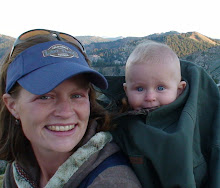Now that you have the basics of yielding the hind quarters working for you, lets move on to yielding the front end. It's quite popular to hear talk of yielding the hind quarters and the one-rein stop, but you don't often hear people taking it to the next step. Moving the front end is the balancing maneuver to yielding the hind quarters. It is the "other side of the coin," if you will. We focus on yielding the hind quarters before moving the front end because hind quarters is the step the horse uses to prepare itself for moving the front.
First it's important that you understand what you are looking for. You want the horse's leading front foot (I'll explain which foot the is in a second) to move out to the side and back a little bit. Then you want the other front foot to cross over the leading foot. If the horse is turning to its left, the left front is the leading foot and the right front is the crossing over foot.
Okay, now on to the mechanics of moving the front end. For this example we will move the horse's front end to the left. Start after your horse has disengaged the hind quarters and is stopped facing you. The lead rope will be in your right hand with the tail of the rope in your left. Step to your right (your horse's left). This puts the horse in a "tight spot" and causes it to rock its weight back on its HQ. Then use your left hand to influence your horse into moving to its left. The horse will end up in the position to track right if you were to send it forward on the circle.
To clear up any confusion, I often tell students to visualize an imaginary line coming out between the horses front feet. Step across that line, then move the horse feet. If you want another step of front end you will need to again step across the line, then move the feet.
Remember you're looking for the leading foot to move first, then the other to cross over. You probably won't get a cross over at the beginning, keep stepping to your right (across the line) and moving the feet until the horses hind quarters remain stationary (pivoting on the outside foot) and the leading front foot moves out and back, resulting in a cross over. Pause to give your horse a release of pressure. With practice you will be able tell whether or not a cross over is going to happen by how that leading foot moves. So pay attention. The sooner you can recognize it and give a release the soon your horse will understand and the happier he will be.
If your horse is moving forward you are probably oriented to far back towards the horse's shoulder. Make sure you stay in front of the horse's nose to "shut the front door" and cause the horse to turn instead of coming forward.
Wednesday, January 7, 2009
Subscribe to:
Post Comments (Atom)

2 comments:
I like your idea about telling people to imagine a line between the horses feet and then stepping across the line and then moving the horses feet, I think that will help with teaching begginers hindquarters/frontquarters. I am going to have to start using that. We hope you and your family had a fun and safe New Year!
I have found it to be a helpful visual and hope you will too!
Post a Comment